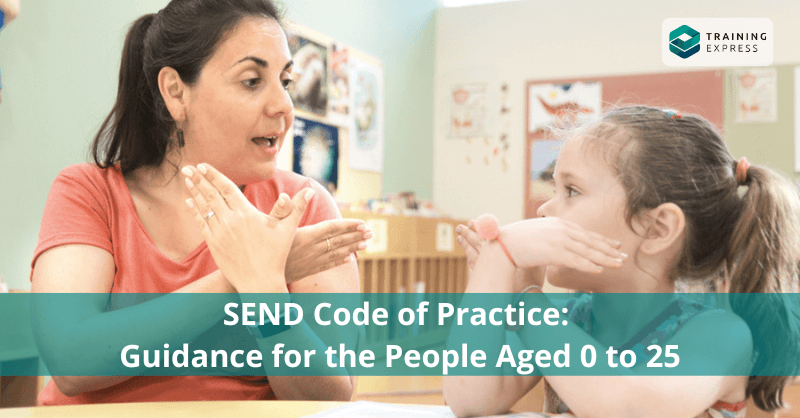

SEND code of practice sets out the specific provision under the Children and Families Act 2014. It is about children and young people aged 0-25 with special educational needs or disabilities. SEND code of practice also contains details of the legal requirements. Education professionals must follow the requirements without exception.
This article will provide you with everything you need to know about SEND code of practice. We’ll also discuss other aspects of SEN to ensure you’re fulfilling the SEND provision correctly. So, let’s get started!
Table of Contents
What is the SEND Code of Practice?
SEND code of practice is considered a statutory guidance. It is a guide for organisations that work with and support children and adolescents with SEND needs. This Special Educational Needs and Disabilities code was enforced in September 2014. And the Department for Education tells all local schools and authorities to abide by the SEND code of practice.
As per the Children and Families Act 2014, every educational authority in the UK must regard the SEND code of practice. Every school must accommodate children with special educational needs and disabilities. The same goes for other academic and educational organisations. On top of that, teachers have to be familiar with the SEND code of practice under this act.
Consequently, the SEND code of practice provides guidance for education settings. It helps take a gradual approach to identify and support students. This is particularly true with special education needs and disabilities.

Moreover, SEND code of practice dictates that schools assess students’ skills and attainment upon entry. Also, schools are advised to make regular assessments of their progress.
For students making below-average progress, schools should make provision for high-quality teaching. And the teaching module should target the children’s specific weaknesses. Even then, assessing the student for SEN becomes necessary if the progress is less than expected.
The school has to implement a four-part cycle process if a student is identified as SEN. The process involves assessing, planning, doing and reviewing. It may also involve collaboration with external specialists.
Sometimes, the student might not make expected progress despite taking action to meet their special needs. In that case, the school or parents can request an educational, health, and care needs assessment.
Why is the SEND Code of Practice so Important?
SEND Code of Practice provides practical guidance on policies and procedures to enable children with learning difficulties to reach their full potential. Moreover, it covers subjects such as inclusion and offers support for children to help them make a successful transition to adulthood.
SEND code of practice ensures a consistent approach. It means that all children with SEND are given the same consideration, which reduces the bias of the “postcode lottery”. While drafting the Children and Families Act 2014, parents were concerned that their children’s needs were not met effectively.
However, the statutory nature of SEND Code of Practice guarantees that everyone is aware of their legal obligations. Also, they can be held accountable if the practices are not being followed.
Who is the SEND Code of Practice for?
People who are aged 0 to 25 years with special educational needs and disabilities fall under SEND code of practice.
The Code of Practice provides statutory guidance for organisations that work with and support children and young people with special educational needs or disabilities. The code is applicable for academies, maintained schools, and free schools.
To be more specific, the code is applicable for:
Principles of SEND Code of Practice
All children, regardless of their needs and disabilities, have a right to education. And the education system should enable them to make progress like any other kids of their age. That is what the SEND code of practice is built on. Basic principles of SEND code of practice lets the children –
The goal is to make the children and young people independent enough to pursue higher education, training or work.
A child with SEN or disabilities might be identified in the early years’ school setting. It could happen in school or college. Regardless of the identification stage, they should have their needs met.
SEND Code of Practice Takes a Child-Centred Approach
Putting the family and young person at the heart of the discussion is the aim of SEND code of practice. It’s also essential to surround the children with support and care.
Thus, parents have a real say in the decisions affecting their children. However, once the young person turns 16, direct consultation with them should be the norm.

Education, Health and Care Plans
Learning difficulty assessments and SEN statements are replacements. They act as replacements for education, health, and care plans. The EHCP binds the child’s educational, health, and social needs into a single legal document. Subsequently, the EHCP should cover every SEND person between the age of 0 to 25 years.
Local Offer
Every local authority must identify and include children and young people with SEN or disabilities. And local authorities must input their information into the directory. This is known as Local offer. In addition, the SEND code of practice advises local authorities to include education services information. Also, health and social care services information should be in the directory.
In addition, the local offer directory must include information about specialist services. It should include services that local people are likely to use outside the local area.
SEN Support According to the SEND Code of Practice
A teacher’s responsibility is to develop and progress students in the class. Even sometimes, students may need support from teaching assistants or specialists. As per the SEND code of practice, SEN has replaced school action. It also replaced school action plus guidelines.

Teachers now have to identify the child’s needs and decide expected outcomes. They also have to make support plans and review progress regularly. Moreover, teachers must inform parents when pupils without EHCP receive additional support. In addition, schools must have a designated teacher responsible for SENCo provision.
On top of that, schools should have a governing body or subcommittee. Their role is to oversee the school’s SEN and disability provision. And children with SEN and disability should engage in school activities. This will help them to learn how to coexist alongside students who do not have SEN.
SEN Information Report
Publishing an SEN information report on the school’s website is a must. Every school should also keep it updated. The report should also contain an outline regarding teaching SEN children and young people. Information regarding parents’ involvement in the child’s education and the arrangements of consultation sessions should also be included.
Budget
In recent years, support available from local authorities has reduced in some areas. However, SEND code of practice dictates local authorities ensure sufficient expertise. And it ensures experience among local early years providers to support children with SEN.
Consequently, local authorities have to ensure that providers receive sufficient funds. Funds help to deliver early education.
Accountability
The SEND code of practice makes teachers more accountable for the progress of all pupils. Even the pupils supported by specialist staff fall under the responsibility of teachers. Authority can check teachers’ performance based on how well they teach SEN children.
Thus, it is important for teachers to know how to identify SEN. And they also have to learn to support pupils with different needs. This calls for appropriate training for teachers. So that they can recognise and support students with SEN and disabilities.
The Role of SENCO in Schools
A qualified teacher designated as SENCO is required in every school.
The SEND code of practice guideline specifies that the governing bodies of mainstream schools must have a SENCO designated teacher. The same rule applies to proprietors of educational academies.

Sometimes, SENCO teachers achieving a national award might be a requirement. For example, the award could be in the special educational needs coordination category. And they should achieve this award within 3 years of appointment. However, an accredited postgraduate degree will be considered equivalent to a national award.
SENCO plays a crucial role in determining the strategic development of SEN policy. They do so in collaboration with the headteacher and governing body. Moreover, the SENCO has an important role in making enough provisions in the school. And they plan their tasks as per the SEND code of practice.
SEND Code of Practice Regarding
Early Years Providers
There is a separate section of guidelines for early years providers. And it sets out the actions these institutions should take to meet their duties. The guideline helps identify and support children with special educational needs. And support comes regardless of whether the child has an EHC plan.
Every child at the early year’s foundation stage is entitled to an education. And it should help them achieve the best possible educational outcomes. It will help them become confident young children. In addition, it should help to communicate their own views.
Early education should get them ready to transition into compulsory education.

EYFS providers should make arrangements to support children with SEN or disabilities. And they should also include an approach to identify and respond to SEN. Because the benefits of early detection are widely recognised. It helps improve long terms outcomes for children. To be precise, practitioners listening to parent’s concerns about their child’s development is crucial
What do Parents Need to Know about
SEND Code of Practice?
Schools or any other authority can make a decision on the special education needs of children. However, they must comply with the SEND code of practice. And the code states that those making decisions must fulfil their statutory responsibilities.
Subsequently, SEND code of practice defines SEN in four broad areas of need and support. And it helps if every parent knows these four areas of need and support.
Communication & Interaction
Often, children find it difficult to understand the language. And that leads to poor communication. The reason behind this could be difficulty understanding a language. It could also be because of a medical condition.
Medical conditions may include autism and auditory processing disorder. Speech disorders or delays and practical language disabilities are also common. A child with SEND can find social communication very difficult. And they also have a hard time managing social situations.
Cognition & Learning

Any child or adolescent might experience a specific learning difficulty. Sometimes, they experience problems with reading and spelling. The condition is called dyslexia. Also, they might experience problems doing mathematics, coordination, or writing. Some other difficulties include working memory, attention, organisation skills, problem-solving, comprehension, etc.
Moreover, children with severe learning difficulties might also experience difficulty learning basic skills. And it might end up affecting their overall development.
Social, Emotional & Mental Health
Often, some children might experience difficulties managing their behaviour or emotions. These difficulties might lead to self-harming, low mood and problems of conduct. Children could also develop substance abuse or eating disorder. In addition, some young children might have recognised disorders. These disorders include attention deficit disorder, attachment disorder and anxiety disorder.
On top of that, children might find it difficult to interact socially with others. Some children might not develop social skills. As such, they lack the social understanding to work or play alongside others.
SEN children will have difficulty taking turns and managing social situations. They could also have difficulty listening to others and picking up on social cues. They might not be able to understand literal language, sarcasm, or implied meaning.
Sensory or Physical Needs
SEND children’s ability to access the environment or learn can get affected. These also include visual or hearing impairments, sensory processing disorders, and physical disabilities. In some cases, children might have a congenital condition such as cerebral palsy.

These four areas of assessment can often overlap. And a child under autism spectrum disorder can have sensory, learning, social, and mental health needs. In rare cases, a child might fall under only one category.
In addition, anyone’s difficulty can fall under several categories. For instance, dyspraxia can be considered a cognition and learning need. However, it often can be a physical need that has an impact on social and emotional development.
Summary of SEND Code of Practice for Schools and How to Meet the Requirements
SEND code of practice states that all children and young people have the right to an appropriate education. It specifically states that all schools are required to identify and address the SEN of the pupils they support.
In order to achieve this, schools are obligated to –
In order to fully understand the implications of the current SEND code of practice, it is imperative for school teams to keep a focus on it. Leadership teams must create a clear and concise framework for how they plan to fulfil each requirement.
As the SEND code of practice contains extensive information as well as corresponding obligations, staffs having regular training and refresher programmes are vital. Staff members should discuss best practices and the latest developments with their peers.
What is the Educational Health Care Plan (ECH)?
SEND code of practice now includes educational health care plans. Local authorities need to provide an EHC plan for any SEN child or young person who will be at a disadvantage without further support. The plan should map out any special educational provision to meet the needs of the pupil or student in question. The goal is to secure the best possible outcomes for SEND children.
Each plan has both short and long-term outcomes that the local authorities and educational providers will work towards. A child’s parent can request an EHC plan assessment from the local authority. While requesting the person must be between the age of 16 to 25, and the person can be acting on behalf of the education provider or school.
SEND Code of Practice Regarding Further Education and Preparing for Adulthood from the Earliest Years
Statutory duties and guidance on further education colleges help institutions identify, assess, and provide support for young people with SEN. Further education institutions are dutiful to secure the special educational provision that the young people attending require. Students in further education colleges will follow a coherent study program that enables them to achieve the best possible outcomes in adult life.

Support may include assistive technology, personal care, interpreters, one-to-one learning support, etc. The support might also include specialist tuition and accessible information such as symbol-based (PECS, for example) or independent living training. Colleges will ensure that the agreed support is put in place with appropriately qualified staff to provide it.
Additionally, discussions and high aspirations are crucial to the success of all pupils. SEND code of practice advice on starting planning longer terms goals as early as possible. Goals should focus on the child’s strengths and capabilities and the outcomes they want to achieve as they transition into adult life. Supporting a SEN person to achieve greater independence and employability can be life-transforming.
Furthermore, professionals working with young people should share the same aspirations. And they must have a good understanding of what support the young person will need. SEND code of practice dictates young people should get the provisions for participating in the community. Young people with SEN should aim for employment and independent living throughout the curriculum and extra-curriculum provision.
Responsibilities of SENCO as per the
SEND Code of Practice
SEN coordinators work to raise educational achievements by leading and coordinating provision for pupils with SEN. SENCO’s responsibilities include designing and delivering interventions to pupils in the classroom. SENCO needs to implement the school strategy per the SEND code of practice.
Further responsibilities of a SENCO include,
Conclusion
There are a lot of guidelines from early years through to 25 year old’s in SEND code of practice. For SEN to be identified, a child or young person does not have to be in the school. SEND code of practice dictates that it is not a requirement.
To learn more about SEND code of practice and SENCO, enrol in SEN Teaching Assistant and SENCO Training. The course will give you the dos and don’ts of becoming a SENCO in detail. Not to mention, you learn how to communicate effectively with SEN pupils through key teaching strategies.
- Available Courses
- Career Bundles73
- Animal care5
- Law8
- Quality Licence Scheme Endorsed111
- Teaching13
- Teaching & Academics Primary27
- Accounting & Finance Primary30
- Training3
- Design9
- IT & Software44
- Healthcare126
- Marketing31
- Health and Safety402
- Construction48
- Electronics25
- Hospitality22
- Health and Social Care219
- Child Psychology37
- Management377
- Business Skills268
- First Aid70
- Employability264
- Safeguarding75
- Food Hygiene103
- Personal Development1277
 Food Hygiene
Food Hygiene Health & Safety
Health & Safety Safeguarding
Safeguarding First Aid
First Aid Business Skills
Business Skills Personal Development
Personal Development












